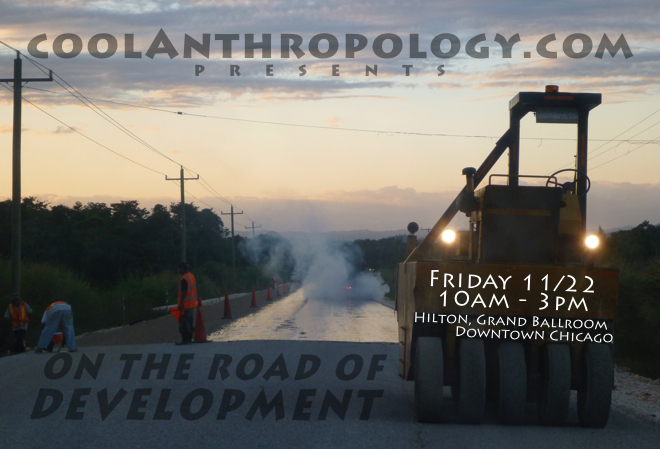The Past is the Future
 Click through to travel the Road of Development right now!
Click through to travel the Road of Development right now!
Innovative and Creative Opportunity for Research Dissemination
Engaging the Future through Engaging the Past invites participants to take a walk down the “road of development,” stopping along the way at interactive stations. Each station will display a representation of a facet of community life and how it has been impacted by development processes. The representations will be made up of a looping video piece, artist interpretations and an interactive component. The looping video will be comprised of select anthropologists relating details of how the particular development process has played out among the communities they have worked with. Participants will be self-guided and can choose to view all or some of the video loops. We are opening the call for anthropologists’ videos for seven stations: religion, education, healthcare, infrastructure, changing economies, changing environments and foods.
Development is a problematic and often-critiqued concept in anthropology. This installation provides a fresh look at some of the elements associated with the development process through a multi-media, interactive exploration of how these themes are interpreted, embraced and incorporated into people’s daily lives. Moving beyond a simple development critique, the installation invites participants to experience how a diverse group of community members, anthropologists and artists interpret particular development events related to specific development forces: religion, education, healthcare, changing economies and foods, as examples. This focus on the diversity of experience highlights a richer understanding of these ubiquitous forces beyond what is “good” and what is “bad,” giving individual community members a voice in the discussion. The installation allows the participants to experience multiple engagements with multiple futures and pasts, with each stop on the road highlighting an aspect of development as it relates to a particular anthropologist’s work, a particular artist’s interpretation and a specific participatory action. This is an embodied experience and participants will use all their senses as they travel down the “road of development.” This event draws on a wide range of field research- from rural Belize, semi-rural Peru, urban Baltimore to New York City. Invited academics and artists represent this wide range of locations, from Miami to Oxford, UK. The installation is ongoing and the “road” is open for participants to arrive at anytime during the session. A minimum of a half hour is suggested to fully experience the installation.
Please be specific about the community of study to which you are referring and avoid generalizations unless they are illustrated by your research.
Please draw primarily on your own research and firsthand experience. You can speak about the work of other scholars but in reference to your own observations.
If you choose to answer questions from multiple categories- and we encourage you to answer as many as you deem relevant- please mention your community of study in your response for each category.
The responses will be edited for future events and online publications, and this will help maintain clarity.
If you choose to speak on a particular category, please answer at least the first question, but feel free to include relevant information not covered by these questions.

Reconsider Dissemination: “The Road of Development” by Victoria Costa and Kristina Baines is licensed under a Creative Commons Attribution-NonCommercial-ShareAlike 3.0 Unported License.


Hey you Cool Anthropologists 🙂 this sounds awesome!
How are the cross-links between individual topics going to take shape? I can see some very cool creative pathways, theoretical cross-links and navigational webs coming on… visitors may potentially get lost in this thing and never get out!
we are all lost in this thing, and will never get out! 🙂
the installation will be setup along a long, narrow “road”. each topic will get its own station, with a looping video of talking head anthros, artwork, an activity and broad information/al graphics. the intro and outro – the beginning and end of the road, if you will – showcases a broad mosaic of images and thoughts, as well as one short film, shown from two perspectives, each respectively at the entrance and the exit of the installation.
I should mention that we really do want to highlight the positive contributions and nuances as well as lay down a thoughtful, anthropological critique of “development” as it plays out in sub/urban and rural communities around the world. I am hopeful the mosaics will inspire congratulatory innovation, if that makes any sense at all haha
the initial audience is for other anthropologists, but- like last year- we hope to bring the exhibition to many different venues throughout the months following its debut in Chicago. as a result, we hope to keep the topics relatively broad, and as standalone pieces that fit into a larger schema, which may not be limited to this exact installation.
we plan to set up a recording station at the end of the road for folks to join the conversation as well! we’ll add everyone’s dialogue to the video/s, and publish them online before the end of the year.
Dr. Kristina Baines will, of course, provide the narrative that ties it all together, but I have heard she works best in collaboration 😉
we are keen to setup Skype calls or Google+ Hangouts to share the more intimate and intricate details as well as discuss your contribution/s.
thanks, as always, for your support and consideration, Amy! sincerely looking forward to your perspective, as well as that of the Nauruan community!
I think it is helpful to know and understand the past in order to understand the present and the future, I also feel like it can never fully be understood. The mind develops everyday and it is very cool to help people develop.